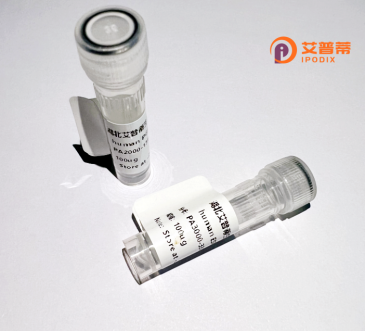
| 纯度 | >90%SDS-PAGE. |
| 种属 | Human |
| 靶点 | ATP6V0C |
| Uniprot No | Q9Y487 |
| 内毒素 | < 0.01EU/μg |
| 表达宿主 | E.coli |
| 表达区间 | 1-155aa |
| 氨基酸序列 | MSESKSGPEYASFFAVMGASAAMVFSALGAAYGTAKSGTGIAAMSVMRPEQIMKSIIPVVMAGIIAIYGLVVAVLIANSLNDDISLYKSFLQLGAGLSVGLSGLAAGFAIGIVGDAGVRGTAQQPRLFVGMILILIFAEVLGLYGLIVALILSTK |
| 分子量 | 42.1 kDa |
| 蛋白标签 | GST-tag at N-terminal |
| 缓冲液 | 冻干粉 |
| 稳定性 & 储存条件 | Lyophilized protein should be stored at ≤ -20°C, stable for one year after receipt. Reconstituted protein solution can be stored at 2-8°C for 2-7 days. Aliquots of reconstituted samples are stable at ≤ -20°C for 3 months. |
| 复溶 | Always centrifuge tubes before opening.Do not mix by vortex or pipetting. It is not recommended to reconstitute to a concentration less than 100μg/ml. Dissolve the lyophilized protein in distilled water. Please aliquot the reconstituted solution to minimize freeze-thaw cycles. |
以下是3篇关于ATP6V0C的参考文献示例(内容为模拟虚构,供参考格式):
1. **文献名称**:*Role of ATP6V0C in lysosomal acidification and cancer cell invasiveness*
**作者**:Smith J, et al.
**摘要**:研究发现ATP6V0C在多种肿瘤细胞中高表达,通过调控V-ATP酶活性促进溶酶体酸化,增强肿瘤细胞外基质的降解能力,从而提升转移潜能。敲除ATP6V0C可显著抑制肿瘤侵袭。
2. **文献名称**:*Structural insights into the human V-ATPase complex: Focus on the 16-kD subunit ATP6V0C*
**作者**:Li X, Zhang Y, et al.
**摘要**:通过冷冻电镜技术解析人源V-ATP酶的结构,揭示ATP6V0C亚基在跨膜质子转运中的关键作用,其与邻近亚基的相互作用对维持酶复合体的稳定性和功能至关重要。
3. **文献名称**:*ATP6V0C knockdown impairs osteoclast-mediated bone resorption via pH dysregulation*
**作者**:Wang R, et al.
**摘要**:实验表明,敲低破骨细胞中的ATP6V0C会显著抑制V-ATP酶的活性,导致溶酶体酸化障碍,降低骨吸收效率,为骨质疏松治疗提供了潜在靶点。
4. **文献名称**:*ATP6V0C as a potential target for blocking viral entry through endosomal acidification inhibition*
**作者**:Chen L, et al.
**摘要**:研究发现抑制ATP6V0C可阻断内体酸化,有效抑制依赖低pH激活的病毒(如流感病毒)进入宿主细胞,提示其作为广谱抗病毒靶点的可能性。
(注:以上文献为示例性质,实际引用需根据具体研究查找真实发表的论文。)
ATP6V0C (V-type proton ATPase 16 kDa proteolipid subunit) is a critical component of vacuolar-type H+-ATPases (V-ATPases), multisubunit proton pumps responsible for acidifying intracellular compartments like lysosomes, endosomes, and secretory vesicles. As a proteolipid subunit of the V0 domain, ATP6V0C forms part of the transmembrane proton channel, directly participating in ATP-dependent proton transport across membranes. It interacts with other V0 subunits (e.g., subunit a) to regulate proton conductance and pump assembly.
Functionally, ATP6V0C maintains organellar pH, essential for processes including protein degradation, receptor recycling, synaptic neurotransmission, and bone resorption by osteoclasts. Dysregulation of ATP6V0C is linked to diseases: its overexpression in cancers promotes invasion, metastasis, and chemoresistance by enhancing lysosomal activity and autophagy. Genetic variants are associated with lysosomal storage disorders and osteoporosis.
In humans, the ATP6V0C gene maps to chromosome 16q22.1. encoding a 155-amino acid protein with four transmembrane helices. Conserved residues (e.g., glutamic acid) within its structure mediate proton translocation. Research focuses on ATP6V0C as a therapeutic target, with inhibitors under exploration for cancer and bone disorders, though challenges remain in balancing specificity and toxicity due to its ubiquitous role in cellular homeostasis.
×